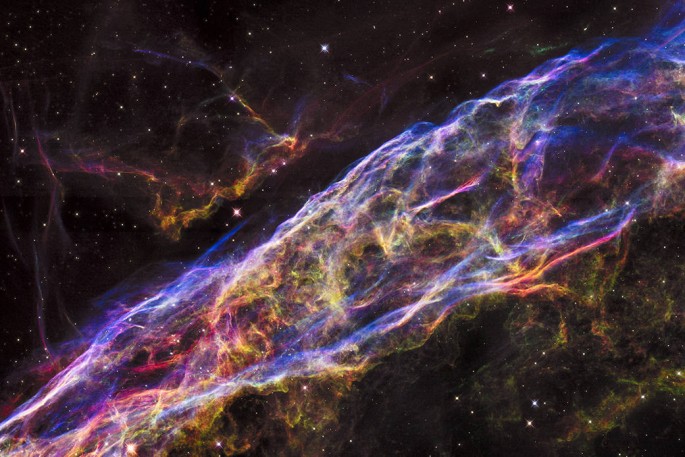Located more than 2,000 light years from our solar system, the Veil floats in cosmic oblivion, enshrouded by remnants of a star shattering away in the constellation Cygnus.
This dying star was once 20 times the size of the sun which exploded into fiery hot gases and dust some 8,000 years ago. This new image captured by the Hubble Space Telescope reveals its remnants slowly drifting away with delicate wisps of star matter.
The Veil Nebula is named after its soft, feathery appearance from the collapsed shrapnel debris of a supernova that shows a two light year section of the stellar structure, spanning 110 light years across.
This image is a composite of six photos taken by the Hubble where it recorded what's left of this forgotten stellar mess, as a dying star ejects powerful forces, blasting star matter of hot gases and dust, resulting in a brilliant explosion that collides into cooler, interstellar gas that is denser.
The myriad cosmic colors also corresponds to a different element where red signifies glowing hydrogen which are now cooler gas that suffered into a shock after collision and is now diffusing into deep space. The thin red wisps also represent where the direction of the shock wave is heading to at speeds of 1 million miles per hour, comparable to travelling from the Earth to the moon in a matter of 15 minutes. The blue arches are composed of oxygen and the eerie green glow of fluffy patches are of sulfur.
NASA released a video including a 3D visualization of how the nebula works, revealing its thin, rippling structure as astronomers describe the exploded star as a "crumpled bed sheet".
To date, astronomers have taken these new images and compared them with the ones captured by the space telescope in 1997 to view how the nebula evolved in the last 18 years. Scientists believe that the supernova that created the Veil Nebula could probably be observed from a visible range on Earth some 8,000 years ago, showing a bright new star in the northern skies.



























